Essentially a 50mm at f2.8 on a 4/3 sensor should more or less equal to what a 35mm camera will produce with a 100mm at f5.6
method
So with a roll of negative film in my 35mm camera and a sunny day to be outside I thought I'd go and expose some film. I armed myself with a 35mm camera with an Olympus 100mm f2.8 lens and put a Olympus 50mm f1.8 onto the G1. Everything was mounted on a tripod and the G1 was carefully focused using the EVF magnification ... naturally 35mm was only focused by eye.
I took images at 1 f-stop intervals starting at f1.8 and going up to the max of each lens.
This actually brought with it a few issues, as in full sunlight my 200ISO film was a little challenged (but coped) while the sensor was washed out at 100ISO at f1.8
That in itself is an interesting finding for me, and worth noting.
Now for the full overview of 35mm Film 100mm at f5.6
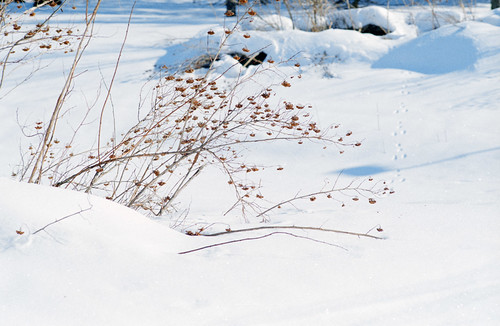
and then, a full overview image from the G1 with the 50mm at f2.8
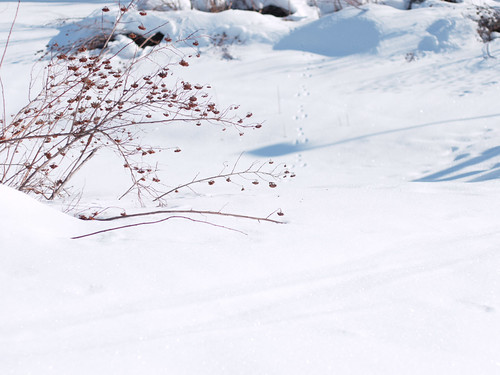
As you can see I did not get the framing perfect, but the foreground (focus point on the bush) and background blur relationships are similar in both. Obviously the 4/3 has a different aspect ratio to the 35mm (which is 3/2) which makes absolute comparison of the views more difficult, but then that was not my aim here. Essentially the 35mm format seems to cover the same vertical view but a slightly wider horizontal view ... again nothing new there. I just wanted to see it myself (rather than just read words).
Now, if we use the f4 image from the 35mm camera and put it against the f4 from the 4/3 we get this (zoomed in a little more for extra clarity)
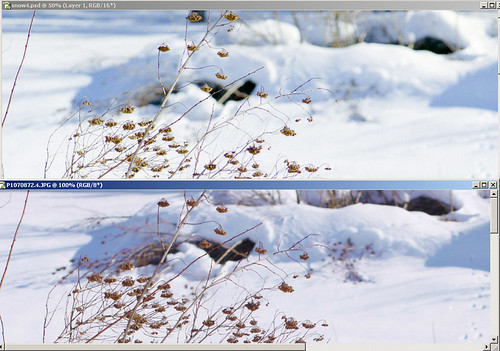
so clearly the 4/3 gives more apparent depth of field at the same f-stop. This is because the diameter of the aperture is the main factor in DoF issues, not the f-stop (please see my other page on that).
F-stop is a relationship of focal length over aperture diameter. It is the ratio of the focal length divided by the diameter of the hole. So the key point in understanding this is that while the angle of view of the 50mm lens on a 4/3 sensor is the same as the angle of view of a 100mm on 35mm (or full frame digital) to get the diameter to be the same number you need to open up the 4/3 lens two stops more.
Thus it can be said that if you are taking pictures with a 4/3 camera for the same depth of field intent you can get an extra 2 stops light (if your lens is fast enough) or use an ISO 2 stops lower and getting the same shutter speed.
People who use full frame digital will say that 800ISO on the 4/3 cameras (like the G1) is about the limit, and their cameras give better clean images at 1600ISO ... well keeping a consistent DoF and shutter speed the same, 2 stops takes you to 3200 on the full frame camera and suddenly the G1's noise looks better (comparing it at 800 to the 5D at 3200)
G1@ 800 -> 5D @ 1600 -> 5D @ 3200



The down side?
Of course if you happen to want a shallower rendering then the smaller format is indeed no longer a benefit. This is particularly significant as you move from tele down to normal and wide. In the above landscape image I found that I really liked the f4 rendering above, which would need f1.4 on my G1 to get the same out of focus look.
Well, that's OK, as I have a 50mm f1.4 lens ... however this reveals another difficulty, and that is contrast. I am not sure why, but the images I see on my comparison (which is problematic being film vs digital) indicated that the 50mm needed to be stopped down to f4 to get better contrast, as it was just not as punchy at 2.8 as was the 100mm, let alone 1.8 especially towards the edges.
This of course can be brought up to some extent in photoshop with local area contrast in unsharp masking.
But with the wide open lens, coping with the bright light of the day (even 100ISO) was causing unrecoverable blowouts of the snow. So you'll need to have a ND filter handy if you wish to be shooting at f1.4 in sunlight.
Below is f1.8 (as my OM 50mm lens is f1.8)
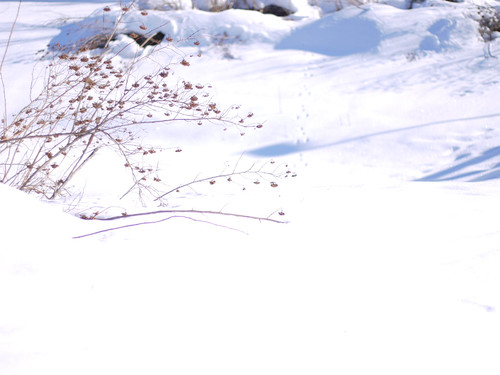
This was 100ISO on the camera (while the negative film was 200), even still the negative didn't have any problems with blow outs. I'd need an ND filter on my G1 to have made f1.4 workable.
Below is the image from full frame with 100mm at f2.8 ... its my favorite of the group because it makes the subject stand out more from the background. I've made this one the largest image (you can click on any of these images to load a larger one, its helpful to do that in a new tab to make better comparisons anyway)

I was intending to post all of them up here (and I still might) but like all research (that I seem to do at least) the examination of the images led me to do something else. I initially intended to put the negs on the glass of my Epson 4990 and just scan them at 2400dpi for an over view. But when I started scanning I found something ...
the unexpected
I was so impressed with the details I saw in my 35mm film, I pulled out my Nikon LS-4000 and scanned the f5.6 image at 4000dpi for a good look at the image.
now, the LS-4000 creates a 5608 x 3657 which makes the horizontal detail a little more magnified than the 4000 x 3000 that the G1 produces from the 4/3 sensor. So I scaled the 35mm image back to be 3000 pixels high and the features matched nearly perfectly in size.
Looking at the focus area the features and detail in the image from the 35mm film shot are simply outstanding

click on either of these images, but remember that then you're looking at 100% view. Your screen is probably 100pixels per inch and a print will be 300 pixels per inch.
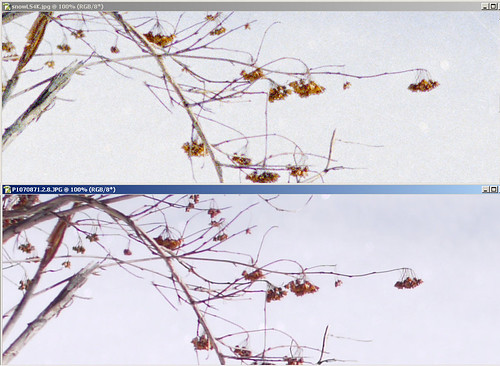
So on a print any of this small amount of grain will essentially blend into the background.
I encourage you to load that above image in a fresh window or tab, and sit back about 2 meters from the screen. That will be about what a close examination of the print will give ... and remember, at the native resolutions printing at 300dpi the 35mm scan will print to 18x12 inches and the 4/3 will print to a slightly smaller 13.3 x 10 inches.
While the G1 image is certainly cleaner in noise the 35mm is actually holding more details. So either will scale up to print larger but I reckon that the 35mm image will look better ... I'm going to have to try that out.
Not bad from 30 year old technology!
While these images may match in depth of field and view, they don't match perfectly in detail ... I think that the 35mm nudges ahead on all counts. Even though this is "merely" 200ISO Fuji Superia negative film.
I know that from other examinations of full frame vs 4/3 that I like the ability to get more shallow rendering from the larger frame and I know that from other examinations that negative has much better ability to grasp at all the scene brightness of a high contrast scene than does digital.
Looking at this I'm now really keen to examine a 5D and compare it again to modern films, because its looking to me like the only thing a full frame digital has over 35mm film is convenience and speed of production.
Its funny how so few examinations of this in the past seem to get the results I'm getting here and now.
Perhaps people don't know how to drive the film scanners ... I don't know.
meanwhile, I'm waiting for some 35mm to come back from a scan on a Hassleblad X-5
keep ya posted












1 comment:
Thanks Chris. Great post. One thing I'd found through my little test was, by using the same lens on different formats, from the same location and cropping into the full frame image to match the m4/3 for instance, the DOF was actually shallower on the m4/3 image when exact same settings were used. Further explained by your explanation above regarding focal length over aperture diameter. With idle time, it's amazing how much I have learned where I used to just 'take pictures'. Thanks for the continued definition, it is much appreciated.
cheers,
Tyson
Post a Comment